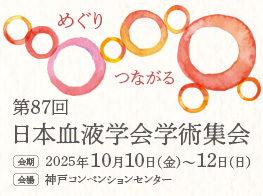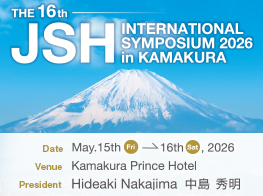名前:藤澤 学【筑波大学血液内科】
発表日時:2017年6月23日
発表形式:Poster Pitch
Title:
Activation of RHOA-VAV1 signaling axis in angioimmunoblastic T-cell lymphoma
Authors:
Manabu Fujisawa1, Mamiko Sakata-Yanagimoto1,2,3, Shoko Nishizawa1, Daisuke Komori1, Paul Gershon4, Maiko Kiryu1, Swarna Tanzima1, Kota Fukumoto1, Terukazu Enami1, Masafumi Muratani5, Kenichi Yoshida6, Seishi Ogawa6, Kosei Matsue7, Naoya Nakamura8, Kengo Takeuchi9,10, Koji Izutsu11,12, Katsuya Fujimoto13, Takanori Teshima13, Hiroaki Miyoshi14, Philippe Gaulard15, Koichi Ohshima14, and Shigeru Chiba1,2,3
Affiliations:
1. Department of Hematology, Graduate School of Comprehensive Human Sciences, University of Tsukuba, Tsukuba, Ibaraki, Japan.
2. Department of Hematology, Faculty of Medicine, University of Tsukuba, Tsukuba, Ibaraki, Japan.
3. Department of Hematology, University of Tsukuba Hospital, Tsukuba, Ibaraki, Japan.
4. Department of Molecular Biology& Biochemistry, UC-Irvine, Irvine, CA, USA.
5. Department of Genome Biology, Faculty of Medicine, University of Tsukuba,
Tsukuba, Ibaraki, Japan.
6. Department of Pathology and Tumor Biology, Graduate School of Medicine, Kyoto University, Kyoto, Japan.
7. Division of Hematology/Oncology, Department of Medicine, Kameda Medical Center, Kamogawa, Japan.
8. Department of Pathology, Tokai University School of Medicine, Isehara, Japan.
9. Division of Pathology, Cancer Institute, Japanese Foundation for Cancer Research, Tokyo, Japan.
10. Pathology Project for Molecular Targets, Cancer Institute, Japanese Foundation for Cancer Research, Tokyo, Japan.
11. Department of Hematology, Toranomon Hospital, Tokyo, Japan.
12. Okinaka Memorial Institute for Medical Research, Tokyo, Japan.
13. Department of Hematology, Hokkaido University Graduate School of Medicine, Sapporo, Japan.
14. Department of Pathology, Kurume University School of Medicine, Kurume, Japan.
15. Inserm U955, Université Paris Est and Département de Pathologie, Hôpital Henri Mondor, Assistance Publique-Hôpitaux de Paris, Créteil, France.
Abstract:
Background: Angioimmunoblastic T-cell lymphoma (AITL) is a distinct subset of peripheral T-cell lymphoma with follicular helper T-cell (TFH) features. We and others previously found mutations of RHOA, encoding p.Gly17Val (G17V RHOA mutation) together with those in an epigenetic regulator, tet methylcytosine dioxygenase 2 in up to 70% of AITL and other TFH lymphoma (a subgroup of peripheral T-cell lymphoma, not otherwise specified (PTCL-NOS)) samples. RHOA, a small GTPase, is converted from the GDP-bound inactive form to the active GTP-bound form by guanine nucleotide exchange factors (GEFs). The G17V RHOA mutant has been shown to be defective in RHOA signaling, because it does not bind GTP. Therefore, it has remained unknown how G17V RHOA is involved in lymphomagnesis. VAV1 serves as an important mediator of T-cell receptor (TCR) signaling pathway through its GEF-dependent and –independent function. VAV1 activation is tightly regulated by autoinhibitory mechanisms in the unstimulated state. Phosphorylation of VAV1 occurs within seconds in response to antigen stimulation of the TCRs by Syk and Src-family tyrosine kinases and initiates downstream TCR signaling.
Aims: We aim at clarifying the downstream signaling of the G17V RHOA mutant in AITL/TFH lymphoma.
Methods: Proteomic screening was performed to identify G17V RHOA-specific binding partners. Binding was validated by co-immunoprecipitation of G17V RHOA and the candidate partners. Simultaneously, RNA sequencing was performed for 9 PTCL samples, including 6 AITL and 3 PTCL-NOS. Targeted deep sequencing of VAV1 was performed for 126 PTCL samples, including 69 AITL and 57 PTCL-NOS, 37 of which had RHOA mutations. The specific binding partner proteins of the G17V RHOA mutant were examined by high throughput screening in Jurkat cells. Nuclear factor of activated T cell (NFAT) activity in response to TCR stimulation was examined in Jurkat cells expressing wild-type (WT) and G17V RHOA mutant, and WT and various VAV1 mutants. Whole transcriptome was compared in Jurkat cells inducibly expressing each cDNA, in conditions with or without TCR stimulation. Expression of phospho-Vav1 was examined by immunostaining for AITL/TFH lymphoma samples.
Results: Proteomic screening identified the VAV1 protein as a G17V RHOA-binding partner. RNA sequencing identified a fusion gene involving VAV1 and STAP2 in an AITL sample without RHOA mutations. Moreover, targeted sequencing of VAV1 identified 2 in-flame deletion mutations in an acidic region (c.C518_529del:p.173_177del and c.C494_520del:p.165_174del) in AITL samples and 2 missense mutations in a zinc finger and SH3-SH2-SH3 module (c.G1668C:p.Glu556Asp and c.C1844T:p.Pro615Leu) in PTCL-NOS and AITL samples, respectively. Phosphorylation of VAV1 at Tyr 174 was enhanced in Jurkat cells expressing the G17V RHOA or VAV1-STAP2 cDNA than those expressing each WT cDNA or mock. Phosphorylation was blocked by the dasatinib at 1-10 nM concentrations. The G17V RHOA, VAV1-STAP2 and various VAV1 mutants enhanced NFAT reporter activities and interleukin-2 (IL-2) mRNA levels compared to their WT or mock in Jurkat cells. Dasatinib completely blocked both of these TCR indicators at the concentration range similar to block VAV1 phosphorylation. Moreover, the aberrant reporter activity was also blocked by the dasatinib treatment. The levels of IL-2 mRNA were higher in Jurkat cells expressing either G17V RHOA or VAV1-STAP2 than those with their WT or mock. Gene set enrichment analysis showed that cytokine and chemokine-related pathways were enriched in Jurkat cells expressing the G17V RHOA compared to those with WT or mock. Finally, phospho-VAV1 was co-stained with PD-1, a TFH marker, in 7 out of 10 PTCL samples with RHOA or VAV1 mutations.
Conclusions: The G17V RHOA and VAV1 mutants both intensify the TCR pathway through hyper-phosphorylation of Vav1. Our data suggest that the RHOA-VAV1 axis in AITL/TFH lymphoma may contribute to their clinical features and stand as a possible new therapeutic target.
EHA2017参加レポート
この度は22nd congress of EHAの参加にあたり、日本血液学会EHA travel awardに採択して頂き、誠にありがとうございました。
学会は、スペインの首都マドリードにて開催されました。6月のマドリードは日中の気温が30度を超えており、じっとしていても汗ばむ陽気でした。これまでアメリカ血液学会に参加したことはありましたが、今回が私にとって初めてのヨーロッパ血液学会の参加となりました。会場はアメリカ血液学会の会場と比較するとコンパクトにまとまっておりました。日本人の参加や発表演題自体はASHと比べると少ないように思いました。
我々は、今回、血管免疫芽球性T細胞性リンパ腫に高頻度に認められるG17V RHOA変異において、その変異体に特異的に結合する蛋白質として、VAV1を同定しました。VAV1はguanine exchange factor (GEF)活性を保有すると同時に、アダプター分子として働くことにより、T細胞受容体(TCR)シグナルを活性化します。G17V RHOA変異体はVAV1と結合することによりこれを活性化し、アダプター分子としての機能を介してTCRシグナルを過剰に活性化しました。さらには、G17V RHOA変異を認めないAITL検体において、VAV1遺伝子変異を同定し、これらのVAV1変異体もTCRシグナルを活性化しました。また、BCR-ABL阻害剤であるダサチニブが、これらのVAV1異常活性化を阻害することを見いだしました。これらの研究成果はRHOA-VAV1経路の活性化がAITL発症の鍵となっていることを示唆し、これを標的とする治療を開拓する可能性を呈示しています。RHOA変異は胃がん等様々な癌で高頻度変異がみいだされていることから、今回の研究はこれらの癌の発症機序を理解する上でも極めて意義深いものだと考えております。
T cell lymphomaに関しては、ポスター、口演セッション共に、それをテーマにした発表は非常に少なかったのですが、その中でも共同研究者でもあるPhilippe Gaulard先生による口演は2016年に改訂されたWHO分類についてのreview、改訂後の新規に出てきた問題点、新規alternationに関する報告、そして今後のPTCLの治療の展望が含まれており、非常に濃密な内容のものでした。また、実際にその後直接お話する機会があり、これからの自身の研究へのsuggestionをいただくことができ、とてもよい経験となりました。
基礎研究に関しては、Müschen先生による pre-B ALLに関する発表が特に印象に残っており、糖、エネルギー供給の転写抑制に対する新規のB細胞の機能を特定しており、細胞内ATPの量をtransformationに不十分なレベルに制限しているというALLの発症と代謝を関連させているというものでした。私にとって基礎研究を始めてからは初の国際学会の参加であり、国際的な知見を深めるとともに、各分野の先生の研究のideaや手法を自身の研究と照らし合わせながら聴講するという大変有意義な時間となりました。
最後になりましたが、このような素晴らしい機会を与えてくださった日本血液学会国際委員会、事務局の皆様に心より感謝いたします。また、日々指導していただいている千葉滋教授、坂田麻実子先生を始め、研究室でお世話になっている先生方、スタッフの方々にこの場を借りて心から感謝申し上げます。



